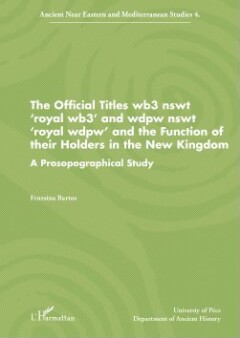Seite 116 [116]
Behind the canopy scene of Thutmose III, there is the false-door of Djehuti (I), on
which his religious titles are clearly shown. Besides these, his title ‘royal wb3 clean of
hands’ also appears. Based on the presence of this title together with the religious ones
on the false-door and in some other scenes in the tomb, one might think that it is closely
connected to the religious function of the owner. However, on examining its appearances
in all the inscriptions in the tomb, as well as in the sources of other titleholders, their
correlation is by no means unequivocal and substantiated.>® In the inscriptions of Dje¬
huti (1), the title ‘royal wb3 clean of hands’ is also presented in the same title string with
whmw nswt ‘royal herald’ and also smsw nswt rww.t=f follower of the king on his journey’.
There is a stele on each end wall of the transverse hall. The one on the southern end
wall contains offering formula and wishes for the deceased for his existence in the neth¬
erworld, and both religious and non-religious titles designate the addressee of these
benefits. The stele on the northern end wall, besides an offering formula, comprises a
section of ideal biography.*° Here Djehuti (1) enumerates the attributes and approach
that an official in the personal service of the ruler must have. Interestingly, while these
features rather characterise a court official in the royal palace, they are accompanied with
the religious titles of Djehuti (I), however, they would have been more appropriate for
his civil offices as ‘royal wb’, ‘royal herald’ or ‘follower of the king on his journey’.’”
Not only functional titles but three out of the five ranking titles also appear in the
inscriptions of the tomb of Djehuti (I). These ranking titles are jrj-p“r h3tj-“ "member of
the elite, foremost of action’, htmtj-bjtj ‘royal sealer’, and smr-w“ fj ‘sole friend’, which
definitely proves his high status in the royal court as well as in society. In addition to this
he bore the title hrd n k3p ‘child of the kap’, probably referring to his common childhood
with and his similar age to Thutmose III. Honorific titles such as mh-jb ntr nfr ‘confidant
of the good god’, jmj-jb n ntr nfr ‘favourite of the good god’ and hsjj n ntr nfr ‘favoured of
the good god’, which are mentioned several times in the inscriptions, demonstrate not
only his close connection with the ruler but also his trusted position by him. The ranking
titles suggest that Djehuti (I) must have originated from the upper classes of society, yet
there is no information on his personal background except for the names of his closest
relatives. His father and mother were called Pesedjiri and Keku respectively, and he mar¬
ried a woman called Baket. The women were ladies of the house, while her father was
identified as s3b ‘dignitary’.
39 See chapter II.4.3 on p. 67.
3° For the ideal and other types of ancient Egyptian autobiography, see Guksch, 1994, 24-25; Gnirs,
1996, especially 203-206.
»" Helck also refers these characteristics to the function of ‘royal wb’, see Helck, 1958, 269.

